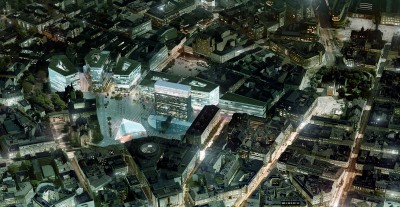While protests rage over plans for a national memorial to the victims of the July 22 terrorist attacks in 2011, consensus seems to be growing over preservation of the high-rise government buildings that were bombed. A majority of architects and professional builders think the building known as høyblokken should remain standing, and new designs are being put forward.

Jan Tore Sanner, the government minister now in charge of the project to rebuild Norway’s government headquarters in Oslo, admits the process is taking a long time. “But we must be certain that we make the right decisions, because it will stand for so many generations in the future,” Sanner told newspaper Dagsavisen recently.
Sanner conducted a hearing on the future of the downtown area called Regjeringskvartalen earlier this month, where the vast majority advocated preservation of the high-rise that once housed the Office of the Prime Minister and the Justice Ministry. All the ministries are now scattered around Oslo while debate goes on over where their new permanent location should be.

Among those favouring preservation of the high-rise are the Norwegian architects’ national association (Norske arkitetkters landsforbund), the national landscape architects’ association, several historic preservation organizations including the state preservation agency Riksantikvaren, design group Norsk Form and city development planners for Oslo Kommune.
Their conclusions defy results of the former left-center government’s own study that last summer recommended the demolition of all damaged buildings including the high-rise, and construction of new.
Sanner doesn’t expect any decisions until after summer at the earliest. More independent architects continue to put forth plans of their own, many of them combining demolition and new construction with preservation of the high-rise. Dagsavisen featured one project, by Transborder Studios, that retains the high-rise at the center of a new government complex, opens up more space to the northeast of it through demolition of the low-rise “Y-blokken” and houses ministries in new atrium-style buildings behind it.

Debate continues, meanwhile, over the shape and scope of the national memorials chosen to commemorate the July 22 attacks and their victims. There will be two memorials, one at the site of the government complex where eight persons were killed and one on the island of Utøya, where 69 persons were gunned down.
The winning concept for the Utøya memorial, chosen by a state jury among eight proposals submitted an international competition, involves literally cutting off part of the island and transporting its hallowed ground to the downtown site. It won praise and support both nationally and internationally, but people living across from the island don’t want such a visible daily reminder of the attacks. Norwegian Broadcasting (NRK) reported on Tuesday that the neighbours are so upset about the Utøya memorial plans that they’re now threatening court action to stop them and have hired high-profile attorney Harald Stabell to represent them.
They contend they haven’t been properly consulted during the memorial selection process. Their objections have surprised state officials, however, and upset some of the survivors and families of those killed on Utøya. Trond Henry Blattmann, who lost his own son on Utøya and has long represented parents of others killed, told NRK that the debate around the memorials is “difficult” and a new burden for the survivors to bear.
Blattmann noted that the state agency in charge of carrying out the government’s decision to create the July 22 memorials, KORO, has called for a meeting with all interested parties. Negotiations between the memorial planners and the residents are expected.
newsinenglish.no/Nina Berglund

